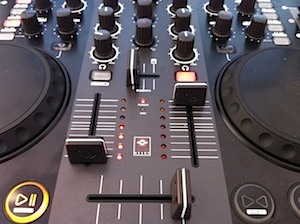
Reader DJ MW writes: “I have decided to sell my CDJs and go digital. However I regularly use a third deck in my sets. I am considering the Mixtrack Pro and I understand that I will need to upgrade to a pro version of whichever program I end up going for to support four channels (probably Traktor) and mapping buttons so that I can switch between decks A and C.”
“My question is: How would it work in relation to volume/pitch controls when switching? Does it lock them in or does it just follow the physical faders when you switch back and change the values, messing up the mix?”
Digital DJ Tips says:
Good question! I cannot be 100% sure with your own mapping using the Mixtrack Pro, as we don’t have one here to test it, but with controllers that are made to use four decks but that only have two sets of faders and knobs, it usually works as follows.
To be clear (for readers who aren’t following), what DJ MW is asking is this: Say you’re on deck A on a controller with two “decks” and two sets of mixer controls but that can control four decks in software. You set the tempo, EQs etc in a certain way, then switch away to deck C (such controllers usually have decks A and C on the left, and B and D on the right). Now, on deck C, you alter all the controls to suit the track playing there, before switching back to deck A. The question is, how does the controller handle those two different sets of settings for bass, mid, treble, gain, fader etc with just the one set of physical controls?
So there are two parts to the answer. Firstly, the actual settings on the deck you’ve returned to will have remain set how you left them, even though the knobs and buttons on your controller are probably set totally differently in the software. This means that the mix won’t have been messed up, as DJ MW feared.
The next question, then, is this: How do you take control again?
Back in the early days of all of this, what sometimes happened was that the second you touched a control, that control “jumped” to the position the hardware was then set to. Not ideal if the tempo was all the way down when you “left” the deck, and the hardware happened to be set with tempo all the way up when you “returned” to that deck!

So a better system was developed and implemented by most. What generally happens nowadays is that the hardware control won’t do anything until you move it back to where it was when you left that deck. So if you left the pitch at fully down, it won’t become “live” again until you move it back to fully down. Then, you can take over from there gracefully, without any sudden change in the control’s setting. It’s sometimes referred to as “soft takeover”.
The only minus point of this is that you do have to keep an eye on the screen to see where the controls are set in the software, to remind you where you have to return the control to in order to make it live again.
So back to your question: I’m hoping a reader can reply in the comments to confirm the actual experience of using a Mixtrack/Mixtrack Pro like this, but if you were to go for a controller designed to work with four decks, like the Reloop Mixage, for instance, this is definitely how it would work.
Can you help DJ MW? Have you every struggled to use four decks on a two-deck controller? Do you successfully DJ in this way, or do you prefer using a full four-channel mixer section with four decks? Please let us know your experiences in the comments.








